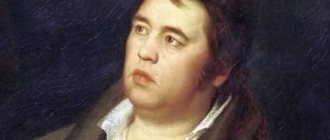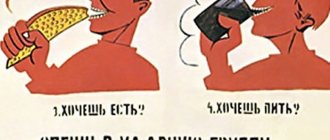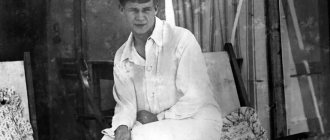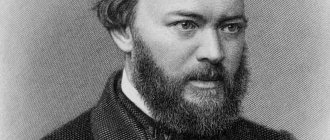- Essays
- Famous people
- Chronological table of Bunin's life and work
Ivan Alekseevich Bunin has an amazing life, filled with wonderful events. Autobiographical motifs are often found in his work, so his life is important for everyone who reads Bunin's works.
October 10, 1870 - birth of the future writer in Voronezh in southern Russia
1881 - As a boy, he was enrolled as a student at the Yeletsk gymnasium
1886 — The future poet was expelled for non-payment of tuition
After this event, Bunin makes his first creative attempts to write.
1887 — the poet’s first works were published in the publication “Rodina”
1889 - Bunin moved to Orel and began working in a local newspaper
1891 — publication of the author’s first collection of poems for the first four years of his work
1895 — The poet leaves Orel and moves to St. Petersburg, and from there to Moscow, where he gradually enters the circle of famous writers
1896 — the poet tries himself in literary translation. The first such experience was working on the poem by the American author “The Song of Hiawatha.” The young poet often returned to work, reworked and supplemented the text
1897-1898 - at this time, two collections were published (stories - “To the End of the World” and poems - “Under the Open Air”), and the young writer started a family
1899 - the poet separates from his wife, leaving behind his son Nikolai, who will die in 1905.
1900 — While on vacation in Yalta, Bunin creates the story “Antonov Apples”
1903 — Bunin was awarded the Pushkin Prize for his translation of “The Song of Hiawatha” and the book “Falling Leaves,” published two years earlier. The poet will receive this award for the second time in 1909 for a collection of poems from 1903-1906.
1911 - publication of the story “Sukhodol”
1917-1919 - the events of two revolutions mean for Ivan Bunin the end of the history of the state, the final decline of the nobility, the beginning of a new, unfamiliar, but in advance unpleasant era. The writer expressed all his impressions about the events in the work “Cursed Days”
1920 — Ivan Bunin left Russia for Turkey
1924-1929 - these are years of fruitful creative work. Bunin created “Rose of Jericho”, “Mitya’s Love”, “Sunstroke”, a collection of the most outstanding poems
1927-1933 — Ivan Bunin is working on his main work, “The Life of Arsenyev.” It is based on events from the life of the poet himself, his feelings and impressions received in reality.
1933 - The writer wins the Nobel Prize in Literature for his work “The Life of Arsenyev”
1950 - The poet publishes the work “Memoirs” abroad
November 8, 1953 - Ivan Alekseevich Bunin dies in the capital of France
Childhood and family
Ivan Bunin was born on October 22, 1870 in Voronezh. He was a representative of an ancient (his roots went back to the 15th century), but impoverished noble family. Among the relatives of the future Nobel laureate were Zhukovsky and the poetess Anna Bunina. Ivan's family was remarkable:
- Father Alexey Nikolaevich only graduated from the first grade of the gymnasium, and at the age of 16 he got a job in the office of the provincial noble assembly. He took part in the Crimean War (1853-1856), returned from it and married his cousin Lyudmila, who was 8 years younger than her husband. According to Ivan's recollections, his father was energetic and temperamental, had great physical strength and at times drank heavily. Despite his lack of education, he constantly read everything that caught his eye.
- Mother Lyudmila Aleksandrovna Chubarova was the opposite of her husband. Meek and pious, she had a great influence on her son.
The Bunin couple had 9 children: in 1857 - Julius, in 1858 - Evgeniy, in 1870 - Ivan, in 1873 - Maria. The remaining children died in early childhood. Ivan was especially impressed by the death of his sister Sasha, the favorite of the whole family. The boy retained his amazement at the power of death throughout his life.
The family moved to Voronezh in 1867 so that Yuli and Evgeniy could enter the gymnasium. In 1874, little Ivan and his parents returned to the family estate on the Butyrka farm in Yeletsk district.
Learning difficulties
The future writer received a good education at home. Thanks to his tutor (a student at Moscow University), he learned to read early, learned several languages, including Latin, and began to draw . Already as a child, the boy read Pushkin, Homer's Odyssey and a collection of English poetry.
In the summer of 1881, Ivan was sent to the Yeletsk gymnasium. In 1886, he came on vacation to Ozerki, where his parents lived, and never returned to study. The boy was expelled from the gymnasium, after which Julius, expelled from Moscow for participating in the riots, became his teacher. Since mathematics caused difficulties for Ivan, emphasis was placed on the humanities.
Bunin's first literary experiments date back to this period. While still in high school, he began writing poetry, and at the age of 15 he composed the novel “Passion” (the editors did not accept it). In 1887, the poet Semyon Nadson, whom Bunin considered his idol, died. The young man wrote several poems and sent them to the Rodina magazine. In February the poem “Over the Grave of Nadson” was published, in May - “The Village Beggar”. The first collection was published in 1891 in a small edition and was sent to subscribers of the Orlovsky Vestnik free of charge.
At the beginning of 1889, Ivan Bunin was offered the position of assistant editor at Orlovsky Vestnik. The young man decided to consult with his older brother and left for Kharkov, where he lived. Having earned a little money locally, Ivan visited Sevastopol and Yalta. He returned home only in the fall and accepted the offer.
At this time, Varvara Pashchenko, a proofreader, worked at the newspaper, with whom the young man fell in love. The relationship did not work out: the girl’s father, a wealthy doctor, was against marriage, and Ivan himself was burdened by constant poverty and instability.
In 1892, Bunin moved to Poltava, where, with the assistance of Yuli, he got a job in the statistical department of the government. Varvara moved next, but this did not help the relationship of the young people. Ivan devoted a lot of time to meetings with Tolstoyans and representatives of populist circles, and constantly traveled. At the end of 1894, Varvara left and married Bunin’s friend Arseny Bibikov. Ivan had a hard time with the breakup; his feelings were reflected in many works, including “The Life of Arsenyev.”
Literary life
At the beginning of 1895, Bunin arrived in St. Petersburg. His sociability and energetic character allowed him to quickly meet many outstanding people: the poet Balmont, the critic Mikhailovsky, the publicist Krivenko and others. In Moscow, he met with Tolstoy, Chekhov, Bryusov, Kuprin, and became a member of the Sreda literary circle. During these years, he traveled a lot, practically did not sit still - he went to Orel, then to Odessa, then to Yalta.
In 1898, Ivan Alekseevich met the editor of the Southern Review Tsakni and his 19-year-old daughter Anna. In September, the young people got married. Despite the significant fortune of the bride, the Bunins continued to be in need. In 1900, pregnant Anna left her husband and gave birth to a son, Nikolai, who died 5 years later from scarlet fever. Public recognition came gradually, in stages:
- The first collection did not cause any reaction.
- The review for the second (“To the End of the World and Other Stories”) was written by about 20 critics; it was rather condescending, although positive.
- In 1898, the collection “Under the Open Air” was published.
- The book “Falling Leaves” (1901) made the writer famous and was even nominated for the Pushkin Prize. In 1903, Bunin received half the prize. This made him famous, but did not help his book sales.
- In 1909, Bunin received the half Pushkin Prize for the second time and was elected honorary academician in fine literature.
In November 1906, Ivan Alekseevich met Vera Muromtseva, the 25-year-old daughter of a member of the Moscow city government, at a literary evening. In the spring of 1907, they traveled around the East and began to live together, but for a long time they could not formalize the relationship, since Anna Tsakni would not grant a divorce.
In the 1910s, the couple traveled extensively throughout Europe and the Middle East. The stories “Mr. from San Francisco”, “Easy Breathing”, “The Grammar of Love” and “Chang’s Dreams” published at this time were warmly received by readers and were a success.
Chronological table of Bunin's life and work
Ivan Alekseevich Bunin has an amazing life, filled with wonderful events. Autobiographical motifs are often found in his work, so his life is important for everyone who reads Bunin's works.
October 10, 1870 - birth of the future writer in Voronezh in southern Russia
1881 - As a boy, he was enrolled as a student at the Yeletsk gymnasium
1886 — The future poet was expelled for non-payment of tuition
After this event, Bunin makes his first creative attempts to write.
1887 — the poet’s first works were published in the publication “Rodina”
1889 - Bunin moved to Orel and began working in a local newspaper
1891 — publication of the author’s first collection of poems for the first four years of his work
1895 — The poet leaves Orel and moves to St. Petersburg, and from there to Moscow, where he gradually enters the circle of famous writers
1896 — the poet tries himself in literary translation. The first such experience was working on the poem by the American author “The Song of Hiawatha.” The young poet often returned to work, reworked and supplemented the text
1897-1898 - at this time, two collections were published (stories - “To the End of the World” and poems - “Under the Open Air”), and the young writer started a family
1899 - the poet separates from his wife, leaving behind his son Nikolai, who will die in 1905.
1900 — While on vacation in Yalta, Bunin creates the story “Antonov Apples”
1903 — Bunin was awarded the Pushkin Prize for his translation of “The Song of Hiawatha” and the book “Falling Leaves,” published two years earlier. The poet will receive this award for the second time in 1909 for a collection of poems from 1903-1906.
1911 - publication of the story “Sukhodol”
1917-1919 - the events of two revolutions mean for Ivan Bunin the end of the history of the state, the final decline of the nobility, the beginning of a new, unfamiliar, but in advance unpleasant era. The writer expressed all his impressions about the events in the work “Cursed Days”
1920 — Ivan Bunin left Russia for Turkey
1924-1929 - these are years of fruitful creative work. Bunin created “Rose of Jericho”, “Mitya’s Love”, “Sunstroke”, a collection of the most outstanding poems
1927-1933 — Ivan Bunin is working on his main work, “The Life of Arsenyev.” It is based on events from the life of the poet himself, his feelings and impressions received in reality.
1933 - The writer wins the Nobel Prize in Literature for his work “The Life of Arsenyev”
1950 - The poet publishes the work “Memoirs” abroad
November 8, 1953 - Ivan Alekseevich Bunin dies in the capital of France
Also read:
Picture for the essay Chronological table of Bunin’s life and work
Popular topics today
Almost everyone respectfully calls my mother Svetlana Vladimirovna. She works as a teacher of Russian language and literature at school. Having raised more than one generation of students who followed in her footsteps
One of the most picturesque corners of Russia is the Republic of Karelia. It was these regions that inspired the Soviet artist Vasily Vasilyevich Meshkov to paint the painting “Golden Autumn in Karelia” in 1950.
The work “Youth” by L.N. Tolstoy is the third part of the trilogy “Childhood. Adolescence. Youth", which describes the fate of Nikolenka Irtenyev and his manhood
1831 - in the village of Gorokhovo, not far from the city of Orel, the future writer Nikolai Semenovich Leskov was born. His early childhood was spent in Orel, where his father, a former seminarian, served as an investigator.
“Viy” by Nikolai Vasilyevich Gogol is one of his most exciting and mysterious works, in which romanticism is closely intertwined with realism. The story is riddled with humor in places.
Revolution and emigration
From the autumn of 1917 to the spring of 1918, Bunin was in Moscow, where he met the revolution. The writer did not accept Soviet power and in the early summer of 1918 he and Vera left for Odessa, from there in 1920 to Paris. The diary from 1918-1920 later became the basis for the chronology of the Damned Days. In 1922, Ivan Alekseevich and Vera were able to get married.
In France, Bunin initially did little work in literature, but his pre-revolutionary works continued to be published . After some time, the writer returned to his work:
- In 1924, “The Rose of Jericho” was published, which included stories written in exile.
- 1925 - “Mitya’s Love”, “Ida”, “Sunstroke”.
- In 1927, the biographical “Life of Arsenyev” began to be published. Bunin finished most of it in 1929, the last part was written in 1930-1933.
- 1933 - the writer received the Nobel Prize. Ivan Alekseevich distributed part of the money to those in need.
In winter, the Bunins lived in Paris, in the summer they moved to a villa in the Alpes-Maritimes. In 1927, Galina Kuznetsova, the wife of an officer who fled Russia, joined the couple. She lived with them intermittently until 1942, and after 7 years she left for the USA. In 1929, the writer Zurov settled in the villa and inherited the Bunin archive.
The Bunins spent the Second World War in a villa, which was located on the outskirts of Grasse. Kuznetsova, Zurov and many acquaintances who needed shelter lived with them. There was a catastrophic lack of money, but the writer refused to work for publications in the occupied lands.
Chronological table of Bunin
The chronological table of Bunin, presented on this page, will be an excellent assistant in studying both at school and at university. It collected all the most important and basic dates of Bunin’s life and work. Bunin's biography in the table was compiled by experienced philologists and linguists. Data presented in the table? written down briefly, which is why information is absorbed twice as quickly.
Ivan Alekseevich Bunin left behind a great legacy, which is still being studied to this day. You can learn about his creative path and the tragedies he experienced from the table, which combines all the stages of the life of the great writer.
1870, October 10 (22) – Ivan Alekseevich Bunin was born in the city of Voronezh.
1881– Ivan Bunin’s parents send their son to the Yeletsk gymnasium.
1886, March - Ivan Bunin was expelled from the gymnasium. The reason was the lack of tuition fees, and Bunin did not return from vacation to study.
1887 – Ivan Alekseevich Bunin is published for the first time - his poems “The Village Beggar” and “Over the Grave of S. Ya. Nadson” are published in the patriotic newspaper “Rodina”;
at the end of this year the same newspaper published two more works by Bunin: “Nefedka”, “Two Wanderers”.
1889 – The young writer moves to Oryol, where he goes to work at Oryol Vestnik.
1891 – “Poems 1887 – 1891” are published in Orel.
1893-1894 – Ivan Bunin falls under the influence of L.N. Tolstoy, so much so that the writer is going to become a cooper. Only with L.N. Tolstoy at a meeting in 1894 was able to persuade Ivan Alekseevich to give up this idea.
1895 – The writer moves to St. Petersburg, and a little later to Moscow, where he begins to get acquainted with the capital’s literary circle: A.P. Chekhov, A.I. Kuprin, V.Ya.Bryusov.
1896 – Ivan Bunin translates the poem “The Song of Hiawatha” by the American writer G. W. Longfellow. Later, the writer will improve this translation and reprint it several times.
1897 – Book of stories “To the End of the World.”
1898 – The writer publishes a collection of his poems “Under the Open Air”;
Ivan Bunin is getting married. Anna Nikolaevna Tsakni becomes his wife, who will give him a son, Kolya, a little later.
1899 – Bunin’s marriage turns out to be fragile and falls apart.
1900 – The writer goes to Yalta, where he meets the founders of the Moscow Art Theater;
writes the story “Antonov Apples”.
1901 – A collection of poems “Falling Leaves” is being published.
1903 – Bunin is awarded the Pushkin Prize for his translation of “The Song of Hiawatha” and for the collection “Falling Leaves.”
1903-1904 – Travels through France, Italy and the Caucasus.
1905 – Ivan Bunin’s only son, Kolya, dies.
1909 – Ivan Bunin receives the second Pushkin Prize for the book “Poems 1903 – 1906”;
becomes an academician of the Russian Academy of Sciences.
1911 - The story “Sukhodol”.
1912, October 27-29 – 25th anniversary of Ivan Bunin’s literary activity.
1917 – The writer lives in Moscow. The events of the February revolution are perceived as the collapse of the state.
1918-1919 - “Cursed days.”
1920, January 26 - Bunin left Russia forever, sailing to Constantinople.
1924 - “Rose of Jericho.”
1925 - “Mitya’s love.”
1927 - “Sunstroke.”
1929 – Bunin’s book “Selected Poems” is published.
1927-1933 – Ivan Alekseevich Bunin is working on the novel “The Life of Arsenyev.”
1931 - "God's tree."
1933 – Ivan Bunin is awarded the Nobel Prize.
1950 – In the capital of France, Ivan Alekseevich publishes the book “Memoirs”.
1953, November 8 – Ivan Alekseevich Bunin died in Paris.
Last years
After the war, the family returned to Paris. In 1946, the USSR offered the emigrants to return, but Ivan Alekseevich refused - he was not the same age, and there were no friends left in Russia. The writer remained a stateless person until the end of his life.
In 1947, Bunin was diagnosed with pulmonary emphysema, and he went to the south of France for treatment. After returning, the writer turned to Sedykh with a request for financial assistance. He agreed with the American philanthropist Atran to transfer a pension for the writer. Money was sent until Atran’s death in 1952.
In October 1953, Bunin's health deteriorated, and on November 8 he died. He was buried in the Sainte-Geneviève-des-Bois cemetery in a Parisian suburb.
short biography
Ivan Alekseevich lived for more than 80 years, after the revolution he emigrated to France, where he died and was buried. He twice received the Pushkin Prize and became a Nobel laureate for his contribution to the development of classical prose. The chronological table of Bunin's life and work briefly indicates the most important events of his biography.
| date | Event |
| October 22, 1870 | Date of Birth |
| 1881—1886 | Studying at a gymnasium, expulsion and transition to home schooling |
| 1887 | Debut in Rodina magazine with several poems |
| 1889 | Moving to Orel, starting work at Orlovsky Vestnik |
| 1891 | Printing of the first collection of poems |
| 1895 | Trip to St. Petersburg and Moscow, meeting writers |
| 1901 | Collection "Falling Leaves" |
| 1903 | Pushkin Prize awarded for "Falling Leaves" |
| 1903—1904 | Traveling with Vera Muromtseva in France, Italy, the Caucasus |
| 1909 | Receiving the second Pushkin Prize |
| 1918 | Departure for Odessa from Moscow due to the revolution |
| 1920 | Emigration to France |
| 1924—1927 | Printing of the stories “Mitya’s Love”, “Sunstroke” and others |
| 1927—1933 | Work on “The Life of Arsenyev” |
| 1933 | Nobel Prize Award |
| November 8, 1953 | Date of death |
Bunin is an outstanding Russian writer and translator, winner of the Nobel Prize in Literature. Having emigrated from Russia after the revolution, he never returned and died in France, where he survived World War II. His bibliography includes poems, short stories, novels and novels, diaries and translations. A biography of Bunin by dates will help you get acquainted with his life and create a plan for a lesson dedicated to the fate and work of the writer.
Chronological table of Bunin
A chronological table of the life and work of Ivan Bunin is presented in this article.
Ivan Alekseevich Bunin
- Russian writer, poet, honorary academician of the St. Petersburg Academy of Sciences (1909), the first Russian laureate of the Nobel Prize in Literature (1933).
Chronological table of Ivan Bunin
| October 10, 1870 | Ivan Bunin was born into an old noble family in Voronezh. |
| 1881 | His parents send him to study at the Yelets Gymnasium. |
| March 1886 | Ivan Bunin was expelled from the gymnasium for non-payment. |
| 1887 | His poems “The Village Beggar” and “Over the Grave of S. Ya. Nadson” were published for the first time in the patriotic newspaper “Rodina”. At the end of this year, the same newspaper published two more works by Bunin: “Nefedka”, “Two Wanderers”. |
| 1889 | Moves to Orel, where he goes to work at Orlovsky Vestnik. |
| 1891 | “Poems 1887 - 1891” are published in Orel. |
| 1895 | Bunin moves to St. Petersburg, then to Moscow, where he meets A.P. Chekhov, A.I. Kuprin, V.Ya. Bryusov. |
| 1896 | Bunin translates the poem “The Song of Hiawatha” by the American writer G. W. Longfellow. |
| 1897 | Book of stories “To the ends of the world.” |
| 1898 | A collection of his poems, “Under the Open Air,” is published. In the same year, Ivan Bunin married Anna Nikolaevna Tsakni, but they would only live together for a year, and their only child died at the age of 5 |
| 1900 | The writer travels to Yalta, where he meets the founders of the Moscow Art Theater. Writes the story “Antonov Apples”. |
| 1901 | A collection of poems “Falling Leaves” is published. |
| 1903 | Bunin was awarded the Pushkin Prize for his translation of “The Song of Hiawatha” and for the collection “Falling Leaves.” |
| 1903-1904 | Travels through France, Italy and the Caucasus. |
| 1907 | Visited Palestine, Syria and Egypt. |
| 1909 | Receives the second Pushkin Prize for the book “Poems 1903 - 1906”. Becomes an academician of the Russian Academy of Sciences. |
| 1911 | The story "Sukhodol". |
| October 27-29, 1912 | 25th anniversary of Ivan Bunin’s literary activity. |
| 1917 | Lives in Moscow. The events of the February revolution are perceived as the collapse of the state. |
| 1918-1919 | "Cursed days." |
| January 26, 1920 | Bunin left Russia forever, sailing to Constantinople. |
| 1924 | "Rose of Jericho" |
| 1925 | "Mitya's love." |
| 1927 | "Sunstroke". |
| 1929 | Bunin's book "Selected Poems" is published. |
| 1927-1933 | He is working on the novel “The Life of Arsenyev.” |
| 1931 | "God's Tree" |
| 1933 | Ivan Bunin is awarded the Nobel Prize. |
| 1950 | In the capital of France, Ivan Alekseevich publishes the book “Memoirs”. |
| November 8, 1953 | Ivan Alekseevich Bunin died in Paris. |
2 comments
You know, your site helps a lot. I’ve been using it for a very long time and I like everything clearly. In literature there are only “A” marks. Thank you!








